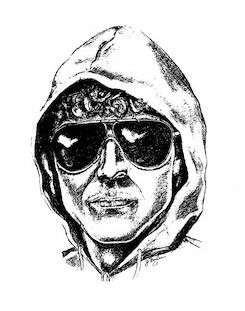Possessing a 167 IQ, admitted to Harvard University at age 16, a uniquely talented mathematician, this former Berkeley college professor became the subject of the longest and most expensive investigation in FBI history.
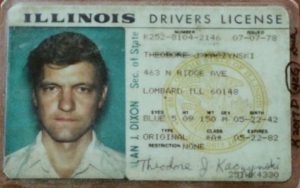
But Kaczynski had another motive for heading to Chicago. Before he left Montana on a Greyhound bus, he constructed the first of his explosive devices. He meant to send it to a professor at RPI, but when he got to Chicago in late May of 1978, the box wouldn’t fit in a mailbox so he merely left it at the University of Illinois-at Chicago in between two parked cars, the device eventually returned to the professor believed to have mailed via the professor’s presumed return address at Northwestern University. But Kaczynski was disappointed when there was not any media mention of what happened with this device. After leaving the device he showed up at his parents’ house without any specific notice.
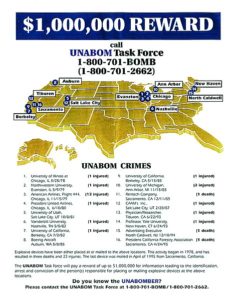
Because a fatality finally occurred, the FBI would not have sole jurisdiction in the ensuing investigation. The homicide division of the Sacramento police department also became involved but immediately found the situation frustrating. Despite their belief that the more publicity about the bomber that was released to the public the better, the Sacramento police were told that, no, the FBI did not want to alert the Unabomber to the fact that they knew of his existence. The local police felt that the FBI was more concerned with the fact that after ten years of bombings, the FBI had no idea who the perpetrator was. The Bureau’s explanation was illogical in that by stamping FC on each bomb the killer was trying to let them know that he was responsible for numerous attacks. This would not be the first FBI investigation that was driven as much by public relations as it was by criminal investigation. Within weeks Sacramento homicide found themselves being excluded from meetings and ignored. Both they and the FBI got nowhere in trying to even begin to figure out who killed Hugh Scrutton.
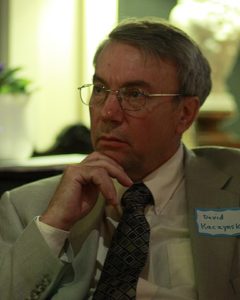
In Schenectady, in mid-1995, David Kaczynski was now the assistant director of the Equinox Youth Shelter, an institution that catered to teenagers. In the summer of 1995, With the high profile of the Unabomber pervading popular media, his wife began suggesting that Ted might have something to do with the bombings. She read that the FBI maintained that the Unabomber grew up in Chicago, spent time in Berkeley and had at least recently travelled to Salt Lake City. Linda Patrik had never met Ted, but was aware of his extreme animosity towards her, had read his correspondence with David and had lengthy conversations with her husband, attempting to convince him that Ted was mentally ill. At first he dismissed the notion, but, as much out of curiosity, he eventually got a hold of the manifesto to see if it resonated in any way. At the same time, Linda got a copy of the initial portion of the manifesto online as the Union College library’s printed copies had been stolen. After the pair read even a small part of the screed, they were both alarmed. Subsequently, unable to dismiss Ted as the perpetrator of these acts, David then went back and documented when he had sent Ted money for loans. It turned out that the devices that killed Thomas Mosser and Gilbert Murray were sent within one month and three months respectively from when checks were sent to Ted.
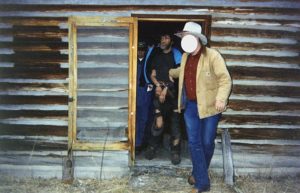
Kaczynski had a habit of not letting strangers inside his cabin, usually stepping outside if necessary and shutting the door behind him. This time, he did not even fully emerge but hesitated with the door open while Burns distracted him with conversation. The Forest Service agent was close enough to grab him by the wrist and after a brief struggle all three men were able to get Kaczynski into handcuffs. He was immediately conveyed to a nearby rented cabin and although talkative, refused to answer any questions about the Unabomber case.
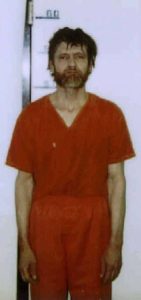
Ted Kaczynski was indicted by a grand jury in June of 1996, on ten counts concerning four of the bombings, including the fatal bombings of Hugh Scrutton, Tom Mosser and Gilbert Murray. Because these bombs either exploded in or were sent from Sacramento, California, Ted was transported to Sacramento, where he would stand trial after being pronounced mentally fit. If convicted, Kaczynski was potentially subject to the death penalty an outcome that his two public defenders were desperate to avoid.
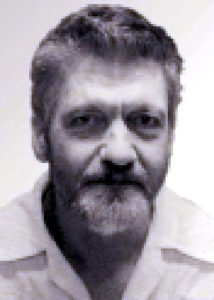
Predictably, Ted Kaczynski, unlike most of his Florence counterparts, including Timothy McVeigh, Ramzi Youssef, Eric Rudolph, shoe bomber Richard Reid, and Zacarious Moussauai, almost seemed to flourish in his new environment. His cell is small, but still larger than the freezing, soot filled shack that was home for 25 years. He has published several book length collections of essays and commentary with the aid of University of Michigan-Dearborn philosophy professor David Skrbina. His correspondence with over 400 individuals and materials relevant to his case was donated to the University of Michigan and is archived in a special collection. Unlike the photographs at the time of his arrest, current official mugshots depict him as well groomed with a pleasant demeanor.
Podcast: Play in new window | Download
Subscribe: RSS

